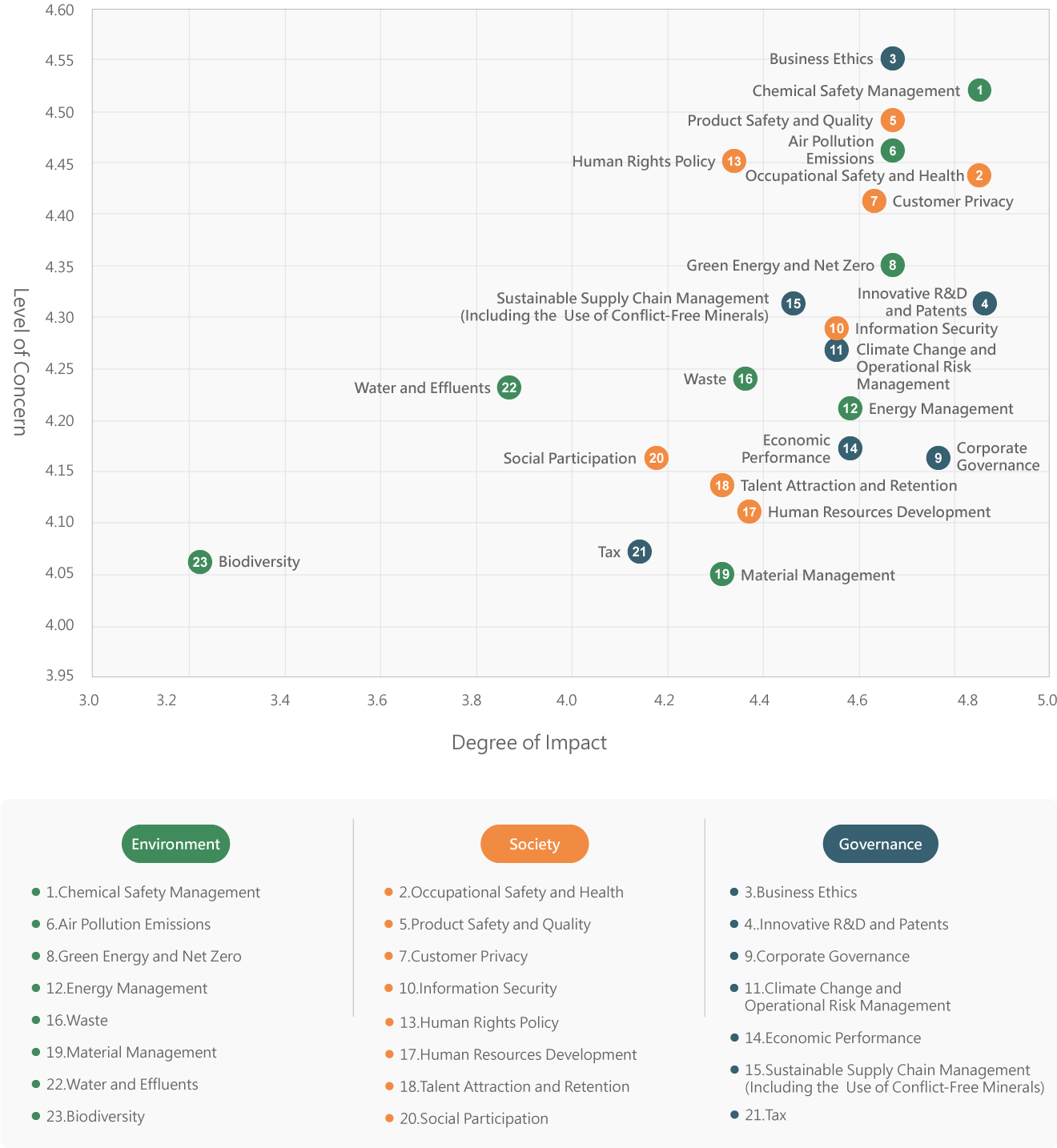To align information disclosed in the sustainability report with stakeholders’ expectations and adhere to international sustainability trends, we establish the framework for analyzing the materiality of sustainable issues based on the materiality identification process within the GRI Standards (2021), which includes six steps: “Understand the organization's context,” “Identify materiality,” “Identify impact,” “Significance assessment,” “Verify material topics” and “Define boundaries of material topics.
1 Understand the organization's context and collect sustainability issues
To understand the organization's context and collect sustainability issues, we refer to the GRI Standards published by the Global Reporting Initiative (GRI), the Sustainability Accounting Standards, the MSCI ESG Leaders Indexes, the FTSE Russell's ESG Index, and the United Nations Sustainable Development Goals (SDGs) as well as key issues of the electronics components industry and feedback from stakeholders. We have compiled a total of 23 sustainable topics covering the three major sustainability aspects: environmental, social (including communities and human rights) and economic (including corporate governance.)
3 major sustainability aspects 23 sustainability topics
2 Identify materiality
Surveys were conducted using questionnaires with a focus on stakeholders’ level of concern regarding each topic (affecting stakeholders’ evaluation and decision making) and the degree of impact on Taiflex's sustainable operations (significant impact on environmental, social (including communities and human rights) and economic (including corporate governance) aspects). The survey results were used as a reference for determining our material sustainability topics. 854 questionnaires were collected in 2023.
15 material topics
3 Identify actual and potential impacts
External ESG experts assessed the actual or potential negative impacts and positive effects of the 23 sustainability topics on environmental, social (including communities and human rights) and economic (including corporate governance) aspects.
15 material topics
4 Assess the significance of the impacts
The overall assessment was determined by adding up and ranking the scores of actual negative impact, potential negative impact, actual positive effects, and potential positive effects of each topic on environmental, social (including communities and human rights) and economic (including corporate governance) aspects. Topics with a total score exceeding 30 were topics with significant impact.
15 material topics
5 Inspect and verify major topics
With reference to the results of materiality identification from stakeholders and the assessment on impact significance by external experts, 15 material topics were determined through internal discussion meetings to be reported in this sustainability report.
15 material topics
6 Define boundaries of material topics
Use value chain as a boundary analysis element for material topics. We will continue to strengthen our management and disclose relevant information in the sustainability report.
Use value chain as the boundary analysis element
Results of materiality identification
Assessment on degree of impact
List of material topics for the year
Material topics for 2023 sustainability report are determined upon materiality analysis, impact assessment, and internal management discussions. With value chain being the boundary analysis element, they are categorized in five chapters: “Practitioner of Sustainable Management,” “Entrepreneur with Steady Progress,” “Developer of Innovative Materials,” “Producer of Green Products” and “Promoter of Social Prosperity,”detailing our proactive management on environmental, social (including communities and human rights) and economic (including corporate governance) issues. In the future, we will continue to strengthen our sustainability management and disclose relevant information in the sustainability report.
List of Material Topics
| Material Topics |
Topics Covered |
Value Chain Impact Boundary |
Page Number |
| Corporate Governance |
Self-defined topics |
Originated |
|
| Climate Change and Operational Risk Management |
Self-defined topics
201-2 Economic Performance
|
Originated
Directly associated
|
|
| Business Ethics |
GRI 206 Anti-competitive Behavior
GRI 205 Anti-corruption
|
Originated |
|
Sustainable Supply Chain Management
(Including the Use of Conflict-Free Minerals)
|
GRI 204 Procurement Practices
GRI 308 Supplier Environmental Assessment
GRI 414 Supplier Social Assessment
|
Originated
Directly associated
|
|
| Material Topics |
Topics Covered |
Value Chain Impact Boundary |
Page Number |
| Economic Performance |
201 Economic Performance |
Originated |
|
| Innovative R&D and Patents |
Self-defined topics |
Originated |
|
| Customer Privacy |
GRI 418 Customer Privacy |
Originated
Directly associated
|
|
| Information Security |
Self-defined topics |
Originated
Directly associated
|
|
| Product Safety and Quality |
GRI 417 Marketing and Labeling
GRI 416 Customer Health and Safety
|
Originated
Directly associated
|
|
| Material Topics |
Topics Covered |
Value Chain Impact Boundary |
Page Number |
| Green Energy and Net Zero |
GRI 302 Energy
GRI 305 Emissions (305-1~5)
|
Originated
Contributed
|
|
| Air Pollution Emissions |
GRI 305 Emissions (305-6, 7) |
Originated |
|
| Waste |
GRI 306 Waste |
Originated |
|
| Material Topics |
Topics Covered |
Value Chain Impact Boundary |
Page Number |
| Human Resources Development |
GRI 202 Market Presence
GRI 401 Employment
GRI 404 Training and Education
GRI 405 Diversity and Equal Opportunity
|
Originated |
|
| Occupational Safety and Health |
GRI 403 Occupational Health and Safety |
Originated
Directly associated
|
|
| Chemical Safety Management |
Self-defined topics |
Originated |
|


